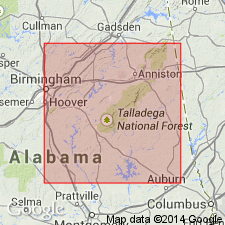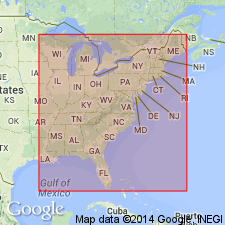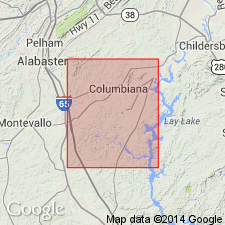
- Usage in publication:
-
- Kahatchee Mountain Group
- Modifications:
-
- Named
- Dominant lithology:
-
- Slate
- Limestone
- Phyllite
- AAPG geologic province:
-
- Appalachian basin
Summary:
The Kahatchee Mountain Group is here named in the southwestern part of the Talladega slate belt in AL. It is the lower structural sequence in the belt and contains the Waxahatchee Slate, Sawyer Limestone, Brewer Phyllite, and Wash Creek Slate. The rocks are dominantly pelitic slate, phyllite, and metasandstone with a minor carbonate unit. Underlies the Sylacauga Marble Group or the Lay Dam Formation of the Talladega Group. The Kahatchee Mountain Group may extend farther northeast and into GA. May be correlative with the Ocoee Supergroup and Chilhowee Group in the Blue Ridge belt. Age is late Precambrian and Cambrian.
Source: GNU records (USGS DDS-6; Reston GNULEX).

- Usage in publication:
-
- Kahatchee Mountain Group*
- Modifications:
-
- Overview
- Areal extent
- AAPG geologic province:
-
- Piedmont-Blue Ridge province
Summary:
Authors follow usage of Tull (1982) as Kahatchee Mountain Group of Talladega block in AL. Base of Kahatchee Mountain is not exposed, nor are any crystalline basement rocks exposed in Talladega block in AL. To the northeast in GA, Kahatchee Mountain Group may unconformably overlie Middle Proterozoic basement (if Mulberry Rock Gneiss proves to be basement). Tull (1982) suggests that Kahatchee Mountain rocks are roughly equivalent to Ocoee Supergroup and Chilhowee Group rocks. McConnell and Abrams (1984) portray northeastern end of Talladega belt, which would be Kahatchee Mountain Group, as continuous into Great Smoky Group. More recently, archaeocyathids have been found in Jumbo Dolomite (McKinney and others, 1988), which is stratigraphically below Sylacauga Marble Group of Tull (1982) and its base is interlayered with lithologies of Kahatchee Mountain Group. Jumbo is correlated with Early Cambrian Shady Dolomite of Valley and Ridge province. The Kahatchee Mountain rocks, like Ocoee rocks, are volcanic-free.
Source: GNU records (USGS DDS-6; Reston GNULEX).

- Usage in publication:
-
- Kahatchee Mountain Group
- Modifications:
-
- Revised
- AAPG geologic province:
-
- Piedmont-Blue Ridge province
- Appalachian basin
Summary:
The four formations of the Kahatchee Mountain Group are subdivided in this report and five new member names proposed. The Waxahatchee Slate is subdivided into the Buxahatchee Creek Member (new) and the Long Branch Sandstone Member (new). The Brewer Phyllite is subdivided into the Sawyer Limestone Member and a conglomeratic sandstone member. The Stumps Creek Formation contains the Watson Creek Sandstone Member (new), and the Wash Creek Slate is divided into a ferruginous sandstone member, the Hillsdale Sandstone Member (new), the Kalona Quartzite Member, and the Mount Zion Church Member (new). Age of the Group has been disputed for many years but is now considered to range from late Precambrian to Early Cambrian. Interlayering of the Mount Zion Church Member with Lower Cambrian dolostones supports an Early Cambrian or older age for the Group.
Source: GNU records (USGS DDS-6; Reston GNULEX).
For more information, please contact Nancy Stamm, Geologic Names Committee Secretary.
Asterisk (*) indicates published by U.S. Geological Survey authors.
"No current usage" (†) implies that a name has been abandoned or has fallen into disuse. Former usage and, if known, replacement name given in parentheses ( ).
Slash (/) indicates name conflicts with nomenclatural guidelines (CSN, 1933; ACSN, 1961, 1970; NACSN, 1983, 2005, 2021). May be explained within brackets ([ ]).

